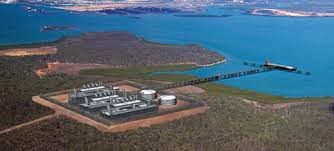A Gloomy Result Season for Australian Majors
Low energy prices continue to have severe impact on financials of major Australian oil and gas producers. The current result season has been extremely lacklustre with Woodside, Santos, BHP Billiton and Origin Energy reporting deep losses or sharply lower profits.
Santos’s $1bn write-down on its 30%-owned Gladstone LNG (GLNG) project has resulted in first half net loss of $1.1bn. During the course of 2016 there has been a slower ramp up of GLNG equity gas production and an increase in the price of third party gas. This has caused Santos to adjust its upstream gas supply and third party gas pricing assumptions for GLNG.

Gladstone LNG: Train 2 started up in May (Credit: Santos)
Excluding impairments and other one-off items, the company recorded an underlying net loss of $5mn. The net debt has reduced to $4.5bn and free cash flow breakeven oil price has dropped to $43.50/b verses $47/b. The company is aiming to be free cash flow break-even at between $35 and $40/b on a portfolio basis.
Woodside remained in the black but saw its half yearly earnings drop a whopping 50% to $340mn owing to an average 26% decline in the realised oil price. The fall could have been worse if the company had not been able to inject greater efficiency in operations. It managed to cut unit production costs by a healthy 38%.
Origin Energy reported $447mn (A$589mn) loss for the full year that ended on June 30, 2016. Underlying profit from continuing operations was $269mn, down 41% on the previous year. The company has been on a debt-reduction drive and it has decided not pay a dividend for the second half. In September last year, Origin stated that in order to lower debt, strengthen the balance sheet and reduce reliance on distributions from Australia Pacific LNG, it plans to reduce the company’s dividend for FY 2016 and FY 2017, make further reductions in capital expenditure and sell non-core assets. The company is planning to reduce its debt below $6.8bn by the end of FY 2017.
Worst among the lot has been BHP Billiton, which reported its first full year loss since BHP and Billiton merged about decade and half ago. It announced a record $6.4bn annual loss impacted primarily by bad bet on US shale. A dam disaster in Brazil and an overall slump in commodity prices also contributed to the loss. Excluding $7.7bn in write-downs and charges, underlying profit still slumped 81% to $1.2bn.
Like other three, BHP too was able to cut costs. Capital and exploration expenditure declined by 42% to $6.4bn and BHP expects it to decrease further to $5bn in FY 2017. On a cash basis, capital and exploration expenditure was $7.7bn and is forecast to decline to $5.4bn in FY 2017.
Worst may be over
Amid all the gloom inflicted by adverse market conditions, intense focus on efficiency improvement emerges as a bright underlying theme. With oil prices now $50./b after hitting a low of $27 a barrel in January, the expectation is that some stability may finally be returning to the market. Higher oil price is certainly a positive for producers. Stable oil prices at elevated levels amid intense focus on efficiency, cost saving and balance sheet strengthening indicate that worst may just be over for these Australian majors.
Shardul Sharma


